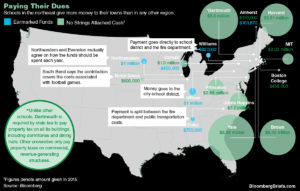Millennials have a definite preference for where they want work and live, which is why universities are aggressively acquiring or leasing real estate, especially in urban areas. Once dormant property owners, universities are using real estate to attract the best and brightest. The result of this property push is college and universities are becoming some of the largest real estate owners in their areas. They invest in the local real estate market to create leverage, longevity and have a positive impact on the community.
Urban Universities Appeal
Urban universities are looking to break the ivory tower stereotype and expand their footprint into the surrounding communities. Since 1996, when University of Pennsylvania decided to invest a billion dollars into the neighboring area, the school has developed more than 3.5 million square feet of industrial, residential, and research space. More than a 100 colleges have studied Penn’s initiative. Johns Hopkins University reported an increasing number of students declining acceptance offers because of the area around the campus. As a result, the school has invested well over $20 million into the community. Many other schools, including Howard University who invested $65 million into surrounding commercial real estate, are following suit and transforming blighted areas into highly desirable neighborhoods.
Studies show that population growth over the past decade in so-called “University Cities” is double the national average. These universities attract highly educated populations whose business and extracurricular interests directly impact the values of commercial real estate. The increasingly popular mixed-use developments carry a high premium. Cultural and art centers, offices, and restaurants are replacing vacant lots. The popularity of urban living also results in job creation of one of the most desirable fields: technology.
Technology and Research Hubs
Major research universities located in urban areas are helping to build a growing” knowledge economy”. Technology and research centers create middle- and-high wage jobs and a resurgence in commercial real estate. Research shows that 20.8% of all leasing activity in the country, last year, was done by tech companies. As of last year, University City in Philadelphia had the lowest commercial real estate vacancy rate (5.5 percent) in the area and enviable rents of nearly $35 a square foot, according to published reports. Its success in transforming a crime ridden, high vacancy area into a sought after tech center has driven rent premiums to 45 percent- the fourth-highest rent premiums in North America. Universities are repurposing older properties to attract and maintain the sought after millennials. As an administrator at Indiana University explained: “building these centers is about seizing opportunities to remain competitive for the long term. By providing incubators for start-ups or research labs for early trials, universities and city governments are cultivating the next generation of tenants”.
Satellite Campus
When the option to build up isn’t financially viable, then you build out…to the burbs. Satellite campuses are becoming a cost solution for many schools. These smaller counterparts to the main campus afford universities greater real estate flexibility. Some universities and colleges with downtown campuses can’t afford the rising city prices. By pushing out to the burbs, they can lease at lower rates while acquiring students who prefer closer proximity to their homes. While many suburban based colleges and universities have gradually bought up prime real estate in college towns, their focus for new acquisitions has shifted. In order to adjust to population concentrations, schools are leasing spaces in office buildings or acquiring sites where they lease the vacant space to external tenants. Many schools are leasing spaces internationally in order to appeal to a greater student population. For-profit universities and colleges also use real estate as a selling point to attract students. University of Phoenix has more than 100 satellite campuses occupying more than five million square feet throughout the country. Hundreds of similar schools lease or own properties throughout the country in order to advertise their accessibility.
The Future of Universities
Capturing the true value of a college or universities’ campus real estate is a challenge. However, investing in property around the campus and investing in the community has proven to not only increase endowment returns, but also boosts enrollment. In the non-profit world of universities and colleges, schools are starting to use real estate as leverage to finance projects that would otherwise rely on donor gifts.
My alma mater, Drexel University has been successful with third party development creating state of the art facilities for instruction, research, and campus housing. In an effort to recruit and retain the best students and faculty, Drexel partnered with developers, retailers, and community leaders to create an exciting new era of development in University City. By shifting the expense and risk of developing campus improvements to third party developers, institutions are able to refocus on the core mission of schools- education and that is a win for everyone.


